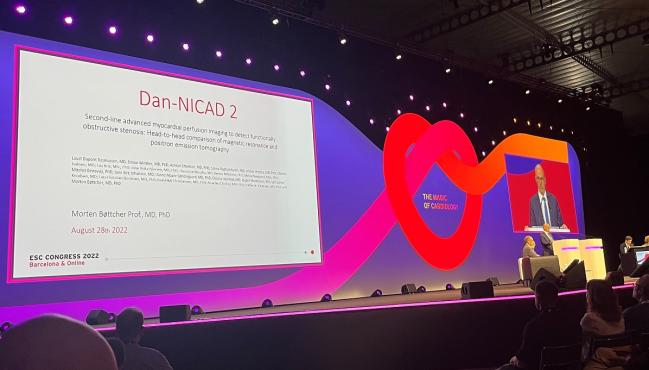CMR, PET Similar for Identifying Coronary Disease After CTA: Dan-NICAD 2
“Patients can be reassured that whichever they are referred for is going to perform just as well” as the other, Colin Berry says.

BARCELONA, Spain—Among patients in whom coronary artery disease cannot be ruled out by coronary CT angiography (CCTA), stress cardiac magnetic resonance (CMR) imaging and positron emission tomography (PET) have comparable accuracy as second-line tests, the Dan-NICAD 2 trial shows.
Though performance is similar between the two, sensitivity is not great for either—ranging from 59% to 64%—when they’re being used to uncover hemodynamically obstructive CAD and fractional flow reserve (FFR) is the reference standard, Morten Bøttcher, MD, PhD (Gødstrup Hospital, Denmark), reported here at the European Society of Cardiology (ESC) Congress 2022.
However, sensitivity improved—ranging from 83% to 90%—when the goal was finding anatomically obstructive CAD, defined as greater than 70% diameter stenosis on 3D quantitative coronary angiography (QCA). Negative predictive value was 95% to 97%.
“There’s absolutely no difference between whether you use an MR or whether you use a rubidium PET scan,” Bøttcher said at a press conference. “The figures for performance are exactly the same.”
The findings demonstrate a continuing dilemma for clinicians, too, as many patients had discrepancies between the results of invasive FFR and noninvasive stress testing. “We now need further studies because we have this group of patients who have a positive perfusion scan and a negative invasive FFR, or vice versa, and we don’t really know how we should treat these patients,” Bøttcher said.
Dan-NICAD 2
For the study, the investigators focused on a common and challenging clinical scenario—when patients, often with risk factors, bring complaints of dyspnea or angina to their general practitioners, who in turn refer the patients to a cardiologist because of suspected ischemic heart disease. The cardiologists then perform a risk assessment and echocardiogram, which are often followed—at least in Bøttcher’s region—by CCTA as the first-line modality for ruling out coronary disease. Danish national databases have shown that in this type of population, CCTA will show that about 50% of patients have normal arteries and another 25% will have suspicious stenoses that require further testing.
It’s not clear what should happen with that latter group—whether they should be treated with medical therapy, go to the cath lab for invasive angiography, or undergo noninvasive ischemia testing. The ESC guidelines on chronic coronary syndromes advise the last option both to document ischemia and to guide potential revascularization, but there are no clear recommendations on choice of modality.
“So we don’t know which technique to use and we don’t know how they perform,” Bøttcher said.
In Dan-NICAD 2, performed across four hospitals in one geographic area, the researchers conducted a head-to-head comparison of rubidium-82 PET and CMR using a 3 Tesla scanner. The study included 1,732 patients (mean age 59; 43% women) with presenting symptoms that were most commonly atypical angina (38.9%), typical angina (20.1%), and nonanginal chest pain (23.4%). All were referred for CCTA, which revealed no lesions or only nonobstructive CAD in about 74%.
The remaining 445 patients were referred for invasive coronary angiography with FFR measurement due to diameter stenosis exceeding 50%, but for the purposes of the study, they first were referred for PET and/or CMR. Ultimately, 372 received all three tests (PET, CMR, and angiography with FFR).
According to FFR, which was used as the reference, 56.1% of patients had nonobstructive disease and the rest had obstructive disease, defined as a high-grade stenosis greater than 90% by visual assessment and an invasive FFR of 0.80 or less. According to anatomically obstructive CAD by QCA, on the other hand, only 19.1% were deemed to have obstructive disease.
Diagnostic performance of PET and CMR were comparable regardless of how obstructive disease was defined. But when they were being used to look for more-severe anatomically obstructive CAD by QCA rather than hemodynamically obstructive disease by FFR, sensitivity and negative predictive value went up, and specificity came down.
Of note, among the 164 patients who had an abnormal FFR, 59 had normal PET results and 67 had normal CMR results.
Reassuring Findings
The study “leads us to conclude, first of all, that in a contemporary population of de novo chest pain patients referred to coronary CTA, the incidence of suspected stenosis is very, very low, only about 25%, and only half of these patients actually underwent revascularization and only half of them had a positive FFR,” Bøttcher said.
Also, he said, second-line perfusion imaging performs better when looking for more-severe stenoses and frequently yields discrepant results compared with invasive FFR measurements.
Asked about the choice of PET or CMR for the types of patients studied in Dan-NICAD 2, Bøttcher said it differs across centers, adding that many hospitals lack the ability to perform CMR. At his center, CMR is used in select patients for whom they want to avoid radiation but PET is used in most.
The similar performance of the two modalities demonstrated in this study is “good for the doctors so that they can choose the modality that they find feasible for this particular patient,” Bøttcher said.
Indeed, “patients can be reassured that whichever they are referred for is going to perform just as well” as the other, commented Colin Berry, MBChB, PhD (British Heart Foundation Glasgow Cardiovascular Research Centre, University of Glasgow), who served as a discussant following the presentation. He noted that centers often only have one of the modalities available, and not both.
Future studies with larger sample sizes, Bøttcher said, will look into how each of the modalities evaluated in Dan-NICAD 2 impact the management of patients when they’re used to guide care.
Todd Neale is the Associate News Editor for TCTMD and a Senior Medical Journalist. He got his start in journalism at …
Read Full BioSources
Bøttcher M. Dan-NICAD 2: perfusion scanning with MR or PET after a positive CT coronary angiography. Presented at: ESC 2022. August 28, 2022. Barcelona, Spain.
Disclosures
- Bøttcher reports serving on advisory boards for Acarix, AstraZeneca, Bayer, Boehringer Ingelheim, Novo, and Sanofi.





Comments